The Dragon’s Blood Tree, scientifically known as Dracaena cinnabari, is a unique and iconic tree native to the Socotra archipelago in Yemen, a group of four islands in the Indian Ocean. It is one of the most distinctive and visually striking tree species in the world.
The Dragon’s Blood Tree is characterized by its umbrella-shaped canopy and dense crown, which resembles an upside-down umbrella or mushroom. It can reach heights of up to 10 to 12 meters (33 to 39 feet) and has a thick, sturdy trunk that tapers towards the top.
The tree derives its name from the deep red resin it produces, known as dragon’s blood, which has been used for various purposes throughout history.
The resin is exuded from the tree’s bark when it is wounded or damaged, and it has been traditionally used as a dye, medicine, incense, and varnish. The resin has a vibrant red color and has been highly valued for its unique properties.
| Taxonomic Rank | Classification |
|---|---|
| Kingdom | Plantae |
| Division | Magnoliophyta |
| Class | Liliopsida |
| Order | Asparagales |
| Family | Asparagaceae |
| Genus | Dracaena |
| Species | cinnabari |
Physical Characteristics of the Dragon’s Blood Tree
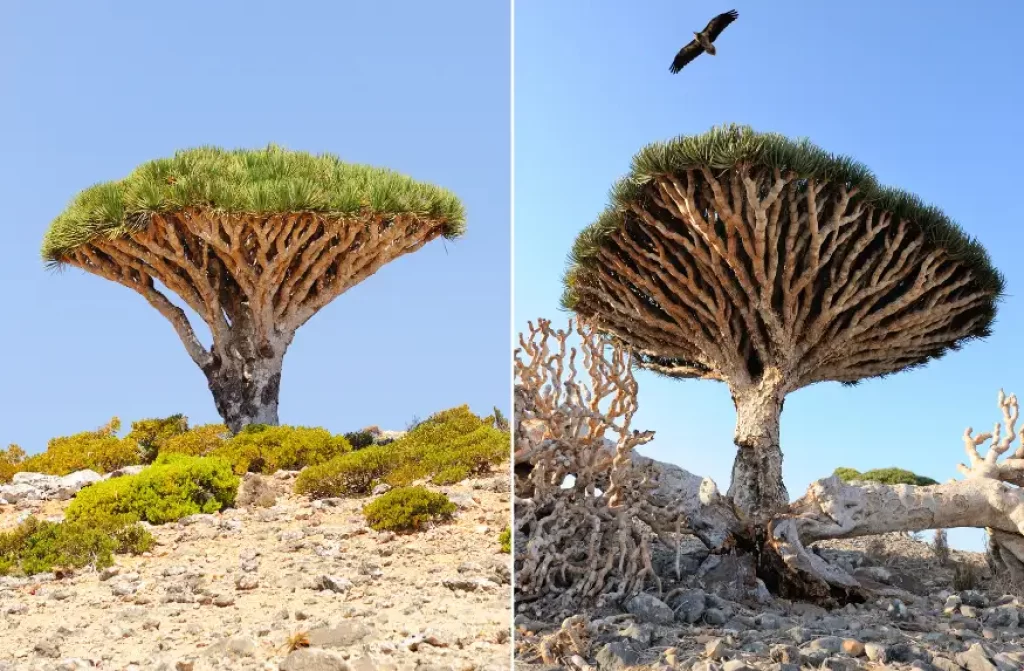
The Dragon’s Blood Tree is characterized by its umbrella-shaped crown of branches that spread outwards.
The trunk is stout, often swollen at the base, and covered in grayish-brown bark. The tree can reach a height of up to 10-12 meters (33-39 feet). Its long, narrow leaves are clustered at the end of the branches and have a leathery texture.
Shape and Canopy
The Dragon’s Blood Tree has a distinct shape that sets it apart from other trees. Its canopy forms an umbrella-like structure, with branches spreading out horizontally. This characteristic gives the tree a visually striking and recognizable appearance.
Trunk
The trunk of the Dragon’s Blood Tree is robust and often exhibits a swollen or bulbous base. It is covered in rough and textured grayish-brown bark. The trunk’s unique shape and texture contribute to the tree’s overall charm.
Size
Mature Dragon’s Blood Trees can reach heights of 10-12 meters (33-39 feet), although some older specimens have been known to grow taller. The height and stature of the tree make it a prominent feature in the landscapes where it grows.
Leaves
The leaves of the Dragon’s Blood Tree are long and narrow, measuring approximately 30-60 centimeters (12-24 inches) in length. They are clustered at the ends of the branches. The leaves have a leathery texture and are typically dark green, with a subtle blue-gray undertone. The unique leaf structure enhances the tree’s visual appeal.
Resin
One of the most fascinating aspects of the Dragon’s Blood Tree is the red resin it produces. When the tree’s bark is cut or damaged, it secretes a dark red sap known as “dragon’s blood.” This resin is visually striking and has been used for various purposes throughout history, such as dyeing, incense, and traditional medicine.
Flexibility
The branches and leaves of the Dragon’s Blood Tree exhibit flexibility, allowing them to bend and sway with the wind. This flexibility reduces the risk of branch breakage and damage. The tree’s ability to flex and absorb the force of the wind helps it to withstand storms and maintain its structural integrity.
The combination of these physical characteristics makes the Dragon’s Blood Tree a truly remarkable species. Its distinctive shape, robust trunk, impressive size, unique leaves, and the captivating red resin all contribute to its allure.
Dragon’s Blood Resin
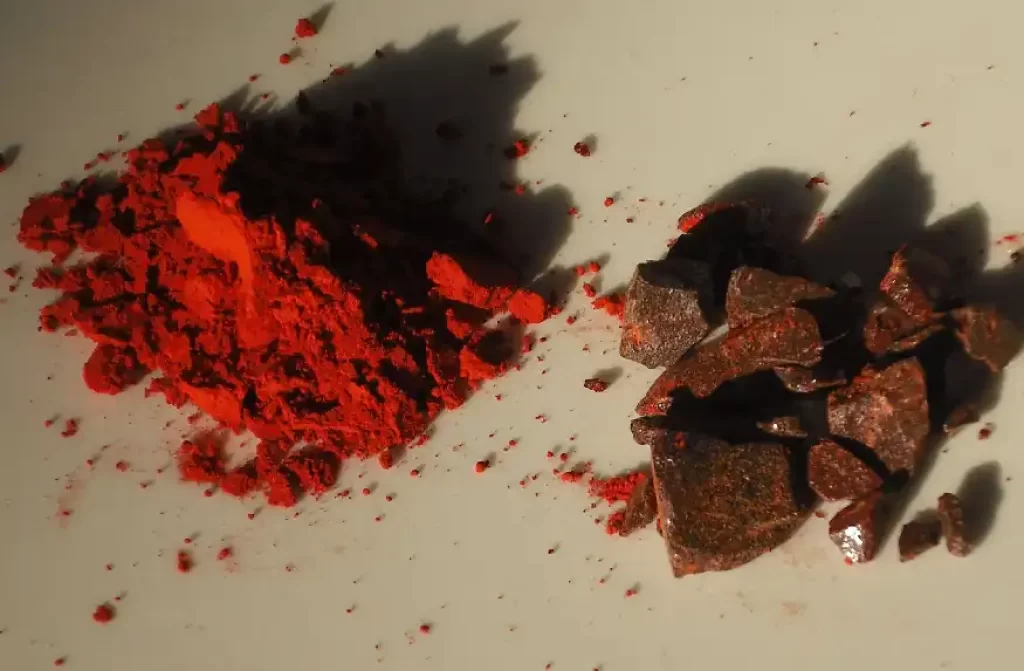
Dragon’s Blood resin is an intriguing and versatile substance derived from the Dragon’s Blood Tree (Dracaena cinnabari). This dark red sap holds cultural, historical, and medicinal significance across different societies. Here are some fascinating aspects of Dragon’s Blood resin:
Historical and Cultural Significance
Dragon’s Blood resin has a long history of use in various cultures. Ancient civilizations, including the Egyptians, Greeks, and Romans, valued its vibrant red color and used it as a dye for textiles and cosmetics.
The resin was also burned as incense in religious rituals and ceremonies. Its association with the legendary creature, the dragon, has contributed to its mystical and symbolic connotations.
Medicinal Uses
Dragon’s Blood resin has been used in traditional medicine for centuries. It is believed to possess a range of therapeutic properties, including wound healing, anti-inflammatory effects, and antimicrobial activity. The resin has been used topically to treat skin conditions, such as cuts, burns, and rashes.
It has also been consumed or applied as a remedy for digestive issues, respiratory ailments, and to support overall wellness.
Modern Applications
In addition to its historical uses, Dragon’s Blood resin continues to find applications in various fields today. It is employed in the formulation of cosmetics, such as lipsticks, nail polishes, and skincare products, to enhance color and texture.
The resin’s unique properties make it desirable for its natural pigment and potential antioxidant and anti-aging benefits.
Conservation Concerns
The demand for Dragon’s Blood resin has raised concerns about the sustainability and conservation of the Dragon’s Blood Tree. Overharvesting and habitat destruction have posed threats to the tree’s population on the Socotra archipelago, where it is primarily found.
Conservation efforts are essential to protect the tree and its resin-producing capabilities for future generations.
Traditional Medicinal Uses of Dragon’s Blood Tree
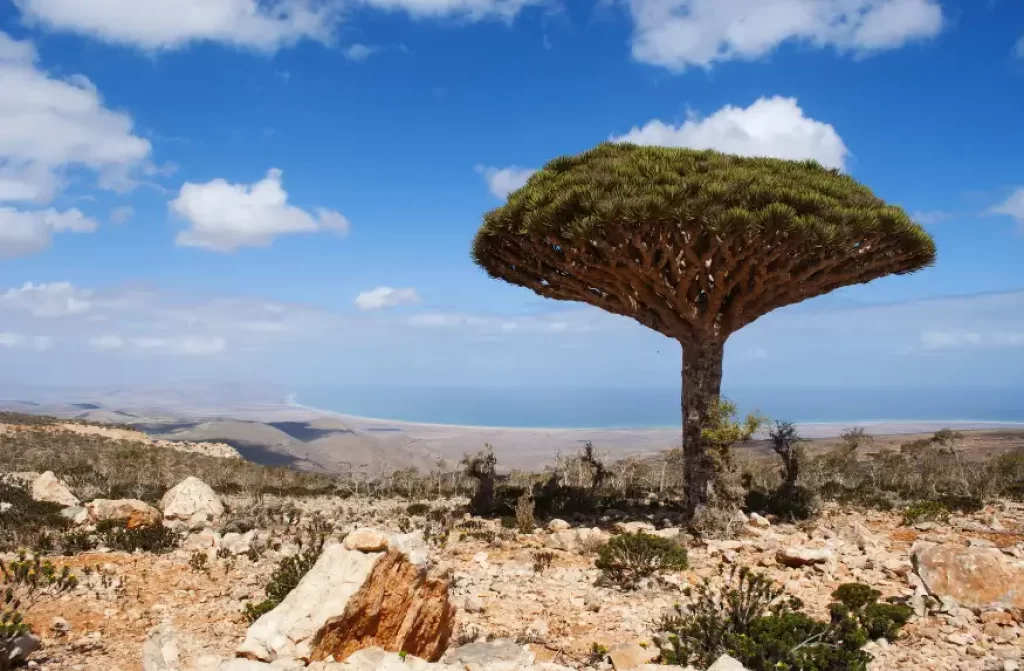
The Dragon’s Blood Tree (Dracaena cinnabari) has a long history of traditional medicinal use in various cultures.
While scientific research on its medicinal properties is limited, it has been attributed with several potential uses in traditional medicine practices. Here are some of the traditional medicinal uses associated with the Dragon’s Blood Tree:
Wound Healing and Antimicrobial Properties:
Dragon’s blood resin has been widely used topically for its purported wound healing properties. The resin is believed to have antimicrobial and antiseptic effects, which can help prevent infection and promote the healing process.
In traditional medicine, it has been applied to cuts, burns, and skin ailments to aid in the recovery of damaged tissues.
Anti-inflammatory and Analgesic Effects:
The Dragon’s Blood Tree resin is also believed to possess anti-inflammatory properties. It has been used traditionally to reduce inflammation and alleviate pain associated with various conditions.
The resin may be applied topically or used in poultices to relieve joint pain, muscle aches, and inflammation caused by injuries or inflammatory disorders.
Gastrointestinal Support
In certain traditional medicine systems, Dragon’s Blood Tree resin has been used to support gastrointestinal health.
It is believed to have properties that can help alleviate digestive issues such as diarrhea, stomach ulcers, and intestinal discomfort. The resin may be consumed internally or used in the form of teas or tinctures to promote digestive well-being.
Respiratory Conditions
The Dragon’s Blood Tree resin has been used in traditional medicine to address respiratory ailments. It is believed to have expectorant properties that can help relieve coughs and clear congestion in the respiratory tract. Some traditional practices involve using the resin in steam inhalation or as an ingredient in herbal remedies for respiratory conditions.
Dermatological Applications
Dragon’s blood resin has been utilized in traditional skincare preparations. It is believed to have skin rejuvenating properties and may be used in creams, lotions, or facial masks to promote healthy skin. The resin is thought to have antioxidant effects, helping to protect the skin from environmental damage and improve its overall appearance.
Habitat and Distribution of the Dragon’s Blood Tree
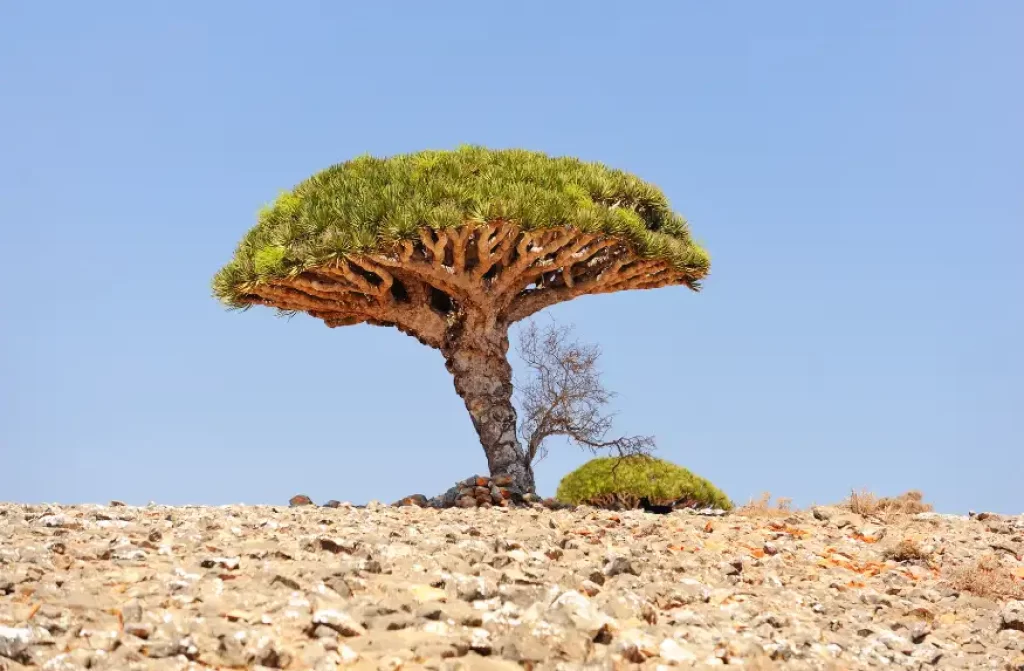
The Dragon’s Blood Tree is endemic to the Socotra archipelago, which is part of Yemen. It primarily grows in arid and rocky landscapes, often found on limestone plateaus and slopes.
The tree has adapted to withstand harsh environmental conditions, including strong winds, limited rainfall, and high temperatures.
Socotra Archipelago
The Dragon’s Blood Tree (Dracaena cinnabari) is endemic to the Socotra archipelago, a group of four islands located in the Arabian Sea.
This remote and isolated region is part of Yemen and has been recognized as a UNESCO World Heritage Site for its rich biodiversity and unique ecosystems.
Arid and Rocky Landscapes
The Dragon’s Blood Tree is well-suited to thrive in the arid and rocky landscapes of the Socotra archipelago.
It is commonly found in areas with limestone plateaus, rocky slopes, and cliffs. These rocky terrains provide the tree with stability and anchorage, even in strong winds and challenging weather conditions.
Semi-Desert Climate
The Socotra archipelago experiences a semi-desert climate characterized by low and erratic rainfall, high temperatures, and strong winds. The Dragon’s Blood Tree has evolved remarkable adaptations to survive in these harsh conditions.
Its thick, succulent leaves help reduce water loss through evaporation, and the tree’s ability to store water in its trunk and branches enables it to withstand periods of drought.
Coastal Areas
The Dragon’s Blood Tree is often found in coastal regions of the Socotra archipelago. Its presence along the coast exposes it to salt spray and strong winds.
The tree’s unique form, with its umbrella-like canopy and slender trunk, allows it to withstand these coastal conditions and minimize water loss.
Endemism and Conservation
The Dragon’s Blood Tree is endemic to the Socotra archipelago, meaning it is naturally found only in this specific geographic region.
The Socotra archipelago is globally recognized as a biodiversity hotspot due to its high levels of species endemism and unique ecological features. However, habitat degradation, illegal logging, and climate change pose threats to the conservation of the Dragon’s Blood Tree and its fragile ecosystem.
Ecological Importance
The Dragon’s Blood Tree plays a crucial role in the Socotra archipelago’s ecosystem. Its canopy provides shade and shelter for a variety of other plant species, and its flowers attract pollinators such as bees and butterflies.
The tree’s fruits serve as a food source for various bird species and small mammals, contributing to the overall biodiversity and ecological balance of the region.
Cultural Significance: Myths, Legends, and Utilization
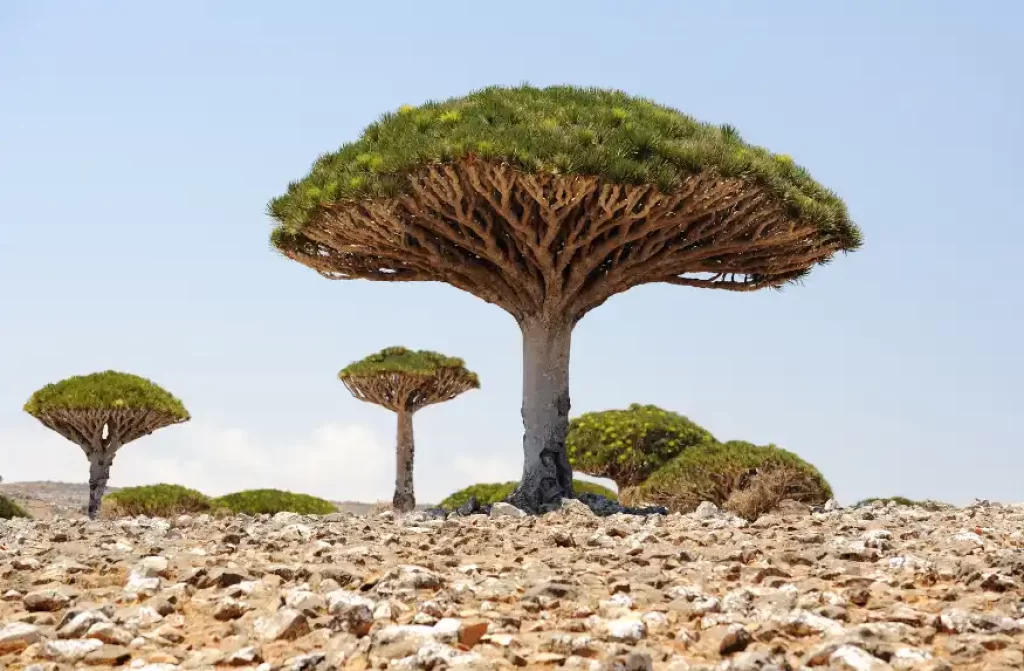
Mythical Associations and Symbolism
The Dragon’s Blood Tree has long been associated with myths, legends, and symbolism. Its unique appearance and the deep red resin it produces have sparked tales of dragons and ancient civilizations. It holds cultural and spiritual significance in the Socotra region and has been revered by local communities for centuries.
Historical Uses and Trade
The dragon’s blood resin has a rich history of utilization. It has been used as a dye, producing vibrant red pigments for textiles, paints, and varnishes. The resin’s aromatic properties have made it valuable as incense, and it has played a role in traditional medicine, believed to possess healing properties.
Cultivating the Dragon’s Blood Tree

Cultivating the Dragon’s Blood Tree (Dracaena cinnabari) outside its native range can be a rewarding but challenging endeavor.
This captivating tree has gained attention for its striking appearance and cultural significance, making it a desirable addition to gardens and landscapes in various parts of the world.
However, successful cultivation requires replicating the tree’s preferred growing conditions and addressing potential challenges.
Selecting the Right Climate
The Dragon’s Blood Tree is well adapted to arid and subtropical climates. It thrives in areas with warm temperatures and low humidity.
In regions with hot summers and mild winters, the tree can flourish. However, in colder climates, special care must be taken to protect it from freezing temperatures, as it is not frost-tolerant.
Providing Suitable Soil
To mimic the tree’s natural habitat, it is crucial to provide well-draining soil. The Dragon’s Blood Tree prefers soil with a sandy or rocky composition, allowing excess water to drain away. Additionally, the soil should be nutrient-rich to support healthy growth.
Adequate organic matter and the right balance of nutrients can be achieved by incorporating compost or well-balanced fertilizers into the soil.
Ensuring Proper Watering
The Dragon’s Blood Tree is adapted to withstand drought conditions but still requires regular watering, particularly during its establishment phase. However, it is important to avoid overwatering, as excessive moisture can lead to root rot.
Allowing the soil to dry out slightly between watering sessions helps maintain optimal moisture levels. Monitoring the soil’s moisture content and adjusting the watering frequency accordingly is essential for the tree’s health.
Providing Ample Sunlight
Like many plants, the Dragon’s Blood Tree thrives in full sunlight. It requires several hours of direct sunlight each day to ensure proper photosynthesis, which is vital for its growth and overall well-being.
When selecting a location for cultivation, choose an area that receives ample sunlight and has minimal shading from surrounding structures or trees.
Protecting from Frost
In regions where frost or cold temperatures are a concern, it is important to protect the Dragon’s Blood Tree from freezing conditions.
Covering the tree with a protective cloth or providing it with a sheltered location during cold spells can help prevent damage to the foliage and trunk. Frost protection measures should be implemented based on the severity of the climate and the specific needs of the tree.
Patience and Care
It is essential to remember that the Dragon’s Blood Tree has a slow growth rate. It may take several years for the tree to reach its full potential, and it requires consistent care and attention during this time. Regular pruning can help shape the tree and promote healthy growth.
Reproduction of the Dragon’s Blood Tree
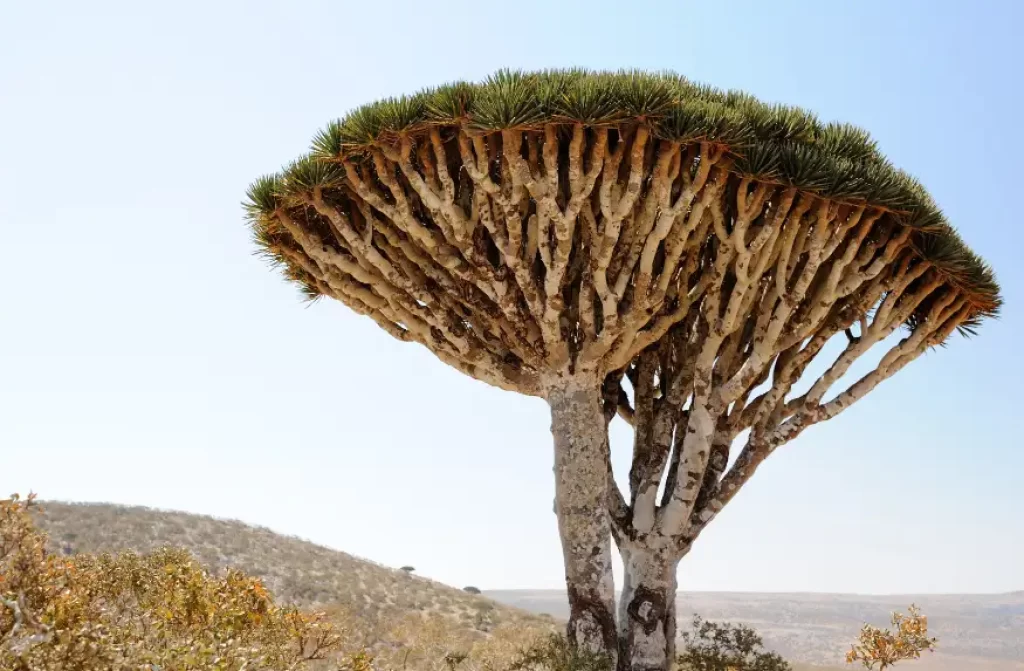
Asexual Reproduction: Offshoots and Suckers
The Dragon’s Blood Tree, scientifically known as Dracaena cinnabari, primarily reproduces through a form of asexual reproduction called vegetative propagation. This process involves the development of offshoots or suckers from the base of the parent tree.
These offshoots grow independently, eventually becoming separate individuals. It’s like the tree is creating clones of itself!
When the conditions are favorable, the Dragon’s Blood Tree sends out these offshoots as a means of expanding its presence in its native habitat.
These offshoots grow from the underground stem, known as the rhizome, which serves as a source of nutrients and support for the emerging individuals. Over time, these offshoots develop their own roots, stems, and leaves, establishing themselves as new trees.
Sexual Reproduction: Flowers and Seeds
While asexual reproduction is the dominant mode, the Dragon’s Blood Tree also has the capability for sexual reproduction. It produces clusters of small, white or cream-colored flowers, which are attractive to insects like bees and butterflies.
These insects play a vital role in the pollination process, transferring pollen from the male reproductive organs (stamens) to the female reproductive organs (pistil) of the flowers.
Once pollination occurs, the flowers undergo fertilization, and small fruits begin to develop. These fruits are fleshy and contain several seeds.
The fruits often have a bright red or orange appearance, adding a splash of color to the tree’s already stunning features.
Seed Dispersal and Germination
The Dragon’s Blood Tree has an interesting mechanism for seed dispersal. The fruits are appealing to birds and other animals, which consume them and subsequently pass the seeds through their digestive systems.
The seeds are then excreted in different locations, aiding in their dispersal away from the parent tree.
The seeds of the Dragon’s Blood Tree have a hard outer coating, known as a seed coat, which provides protection against harsh environmental conditions.
This durability allows the seeds to withstand dry periods and other challenging circumstances until the conditions are suitable for germination.
It’s worth noting that the germination process of Dragon’s Blood Tree seeds can be slow and unpredictable. Factors such as temperature, moisture, and soil conditions play a crucial role in determining when and where the seeds will sprout.
The Blend of Reproductive Strategies
The combination of asexual reproduction through offshoots and sexual reproduction through flowers and seeds ensures the Dragon’s Blood Tree’s resilience and adaptability. Asexual reproduction allows for the rapid expansion of the species, while sexual reproduction introduces genetic diversity and potential adaptation to changing environments.
You might also like
- All About Common Sunflowers
- Growing Frangipani in Pots
- Titan Arum
- Welwitschia mirabilis: The Living Fossil of the African Desert
- Growing Japanese Maple: Care Tips & Cultivars
FAQ

Is dragon blood tree poisonous to humans?
The Dragon’s Blood Tree (Dracaena cinnabari) is not known to be poisonous to humans. While the red resin it produces, also called dragon’s blood, has been used in traditional medicine and cultural practices, it is generally considered safe for external use. However, as with any plant or natural substance, it is important to exercise caution and avoid ingestion unless under the guidance of a knowledgeable healthcare professional.
What is the another name of Dracaena Cinnabari?
Another name for Dracaena cinnabari is the Socotra Dragon Tree. The tree gets its name from the red resin it produces, which is often referred to as dragon’s blood.
What are the dangers of dragon tree?
The Dragon’s Blood Tree (Dracaena cinnabari) does not pose significant dangers to humans. However, there are a few aspects to be aware of:
- Thorny branches: The tree has long, sharp thorns on its branches, so it is advisable to exercise caution when handling or working around the tree to avoid accidental injuries.
- Potential skin irritation: Some individuals may experience skin irritation or allergic reactions when in contact with the sap or resin of the Dragon’s Blood Tree. It is always a good idea to wear protective gloves when handling the tree or its products.
- Limited availability: The Dragon’s Blood Tree is a protected species, and its collection or removal from its native habitat is strictly regulated. Therefore, obtaining or possessing these trees may be illegal in certain areas.
It’s worth noting that these potential dangers are relatively minimal, and the Dragon’s Blood Tree is generally considered safe when handled with care and respect for its natural habitat.
Why is the dragon blood tree endangered?
The Dragon’s Blood Tree (Dracaena cinnabari) is endangered primarily due to habitat loss, climate change, unsustainable harvesting, and its limited distribution. Habitat destruction, including deforestation and urbanization, has reduced the tree’s population. Climate change impacts its growth and survival. Unsustainable harvesting of its valuable resin, known as dragon’s blood, has further threatened its population. Additionally, the tree’s restricted distribution makes it more vulnerable. Conservation efforts are underway to protect the species and its habitat.







